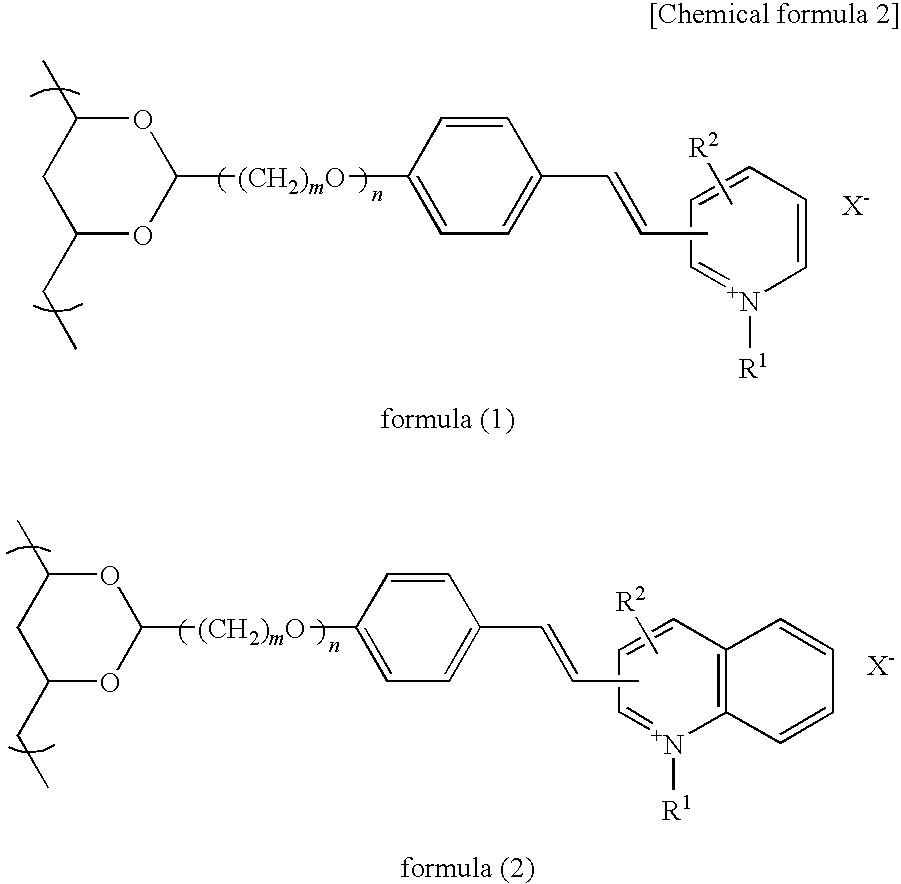Photosensitive resin composition, and photosensitive film and stencil for screen printing using the photosensitive composition
a resin composition and composition technology, applied in the direction of photosensitive materials, impression caps, instruments, etc., can solve the problems of poor storage stability, low photosensitization speed, water-soluble diazo resin not suitable for thick photosensitive layer, etc., and achieve excellent workability
- Summary
- Abstract
- Description
- Claims
- Application Information
AI Technical Summary
Benefits of technology
Problems solved by technology
Method used
Image
Examples
example 1
[0087]A poly(vinyl alcohol) having an average degree of polymerization of 1800 and a degree of saponification of 88% (40 g) was dissolved in 500 mL of water. 1-Methyl-4-(formylphenyl)pyridinium methosulfate (3.65 g) and 5 g of 850% phosphoric acid were added to the solution, and the mixture was stirred for 12 hr. This reaction solution was rendered neutral with an ion exchange resin and was then mixed with 5 g of a monoethanolamine salt of methacryloyloxyethyl phosphoric acid. A solution of 2.5 g of 2-methyl-1[4-(methylthio)phenyl]-2-morpholinopropan-1-one as a radical photoinitiator dissolved in 80 g of pentaerythritol triacrylate was added to the solution with stirring to prepare a photosensitive resin composition.
example 2
[0088]3-Pyridinealdehyde (10 g) was dissolved in 50 mL of ethyl acetate. Dimethylsulfuric acid (11.8 g) was added dropwise to the solution, and the mixture was allowed to stand at room temperature overnight to give 19 g of crude 1-methyl-3-formylpyridinium methosulfate as a brown oil. A poly(vinyl alcohol) having an average degree of polymerization of 1800 and a degree of saponification of 88% (40 g) was dissolved in 500 mL of water. 1-Methyl-3-formylpyridinium methosulfate (10.6 g) and 5 g of 85% phosphoric acid were added to the solution, and the mixture was stirred at 80° C. for 24 hr. The temperature of the reaction solution was returned to room temperature before 3.65 g of 1-methyl-4-formylpyridinium methosulfate was added to the reaction solution followed by stirring for 12 hr. This reaction solution was rendered neutral with an ion exchange resin. The aqueous solution was then mixed with 5 g of a monoethanolamine salt of methacryloyloxyethyl phosphoric acid. A solution of 2.5...
example 3
[0089]A cation modified poly(vinyl alcohol) CM-318 (degree of polymerization: 1800, degree of saponification: 88%, manufactured by Kuraray Co., Ltd.) (40 g) was dissolved in 500 g of water. The solution was adjusted to pH 1.5 to 2.0 by the addition of phosphoric acid. 1-Methyl-4-(formylphenyl)pyridinium methosulfate (3.65 g) was dissolved in the solution, and the mixture was stirred to give an aqueous photocrosslinkable poly(vinyl alcohol) solution having an introduction ratio of 1.5 mol %. This aqueous solution (300 g) was then mixed with 5 g of a monoethanolamine salt of methacryloyloxyethyl phosphoric acid. A solution of 2.5 g of 2-methyl-1[4-(methylthio)phenyl]-2-morpholinopropan-1-one as a radical photoinitiator dissolved in 80 g of pentaerythritol triacrylate was added to the solution with stirring to prepare a photosensitive resin composition.
PUM
| Property | Measurement | Unit |
|---|---|---|
| mol % | aaaaa | aaaaa |
| thickness | aaaaa | aaaaa |
| degree of polymerization | aaaaa | aaaaa |
Abstract
Description
Claims
Application Information
 Login to View More
Login to View More - R&D
- Intellectual Property
- Life Sciences
- Materials
- Tech Scout
- Unparalleled Data Quality
- Higher Quality Content
- 60% Fewer Hallucinations
Browse by: Latest US Patents, China's latest patents, Technical Efficacy Thesaurus, Application Domain, Technology Topic, Popular Technical Reports.
© 2025 PatSnap. All rights reserved.Legal|Privacy policy|Modern Slavery Act Transparency Statement|Sitemap|About US| Contact US: help@patsnap.com



